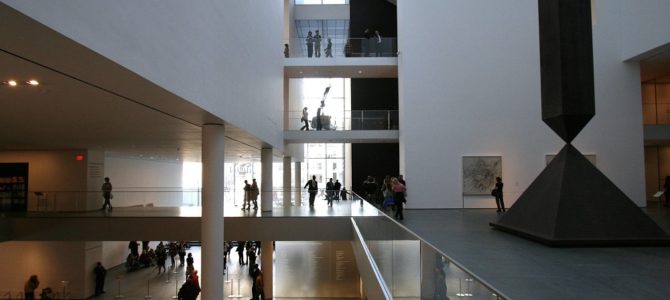
At first glance, “Private Lives, Public Spaces,” an exhibition of home movies that opened recently at the newly renovated flagship building of the Museum of Modern Art (MoMA) in New York, might seem to be little more than a collection of flickering objects of no great importance. Yet many of these films are the precursors to what we post and share in our social media stories today, documenting how the world has changed since people first began picking up home cameras to film themselves and others.
In addition, at least for a certain segment of the population, there’s something much deeper than social commentary at work in this fascinating show. It wasn’t intended, perhaps, by the exhibition organizers, but the effect is more substantial than a mere curiosity romp through other people’s lives.
What It’s Like to Walk Through the Exhibit
The exhibition installation consists of 100 screens of various sizes, divided over two floors, each of which runs different clips of home movies in MoMA’s permanent collection. There are also examples of the types of home movie cameras, some of them quite ancient technology indeed, that were used to capture these images.
At first, the film portion of the show is a bit disorienting. It’s rather like walking through a display of televisions at an electronics store, where each of the glowing boxes is running a different channel with the sound muted. One can also imagine the experience is what it might be like to walk around inside the video portion of a social media feed.
After getting over the initial confusion, when you stop to watch the films on display you quickly realize the wealth of material held in the museum’s archives. The very first film displayed in the exhibition is an interesting choice: a home movie memorializing when MoMA was reluctantly forced to give up (arguably) the single most important object it had on display for decades, “Guernica” (1937) by Pablo Picasso (1881-1973).
The artist asked MoMA to hold on to the painting after the Spanish Civil War, but in accordance with Picasso’s wishes, in 1981 the painting was sent to Madrid, and now resides at the Reina Sofia Museum. The grainy, blurry film shows MoMA staff carefully preparing the monumental canvas for its final journey to Spain. It’s an important moment in art history, and one many people have never seen.
Some of the films selected for the show feature individuals whose names may be familiar to many of us, but whose faces may not be. For example, we see clips of sculptor Constantin Brancusi (1876-1957), composer Aaron Copeland (1900-1990), and painter Marc Chagall (1887-1985) at work and play, chatting with friends, or mugging for the camera. In many of the movies, however, the subjects are just ordinary people picking up a camera to record particular events in their lives, and sometimes we don’t even know the names of the individuals who appear on screen.
Familiar Strangers
Even when their identities are unknown to us, however, the people and situations seem very familiar. We see celebrations such as first communions, graduations, and weddings, vacation shots from places like Egypt and India, or what we might presume are just test films of people trying out their brand-new cameras for the first time. There are also clips of workers going on strike, kayakers and hunters out in nature, religious processions, and moments of unintentional humor caught on film that would be popular on social media even today.
For example, in one film dating to the 1930s, an unnamed young woman is shown approaching a chain-link fence, on the other side of which is a kangaroo. The kangaroo comes up to the fence, attempts to embrace the young woman, then does what kangaroos inevitably do: try to knock her lights out. One can’t help but laugh, and realize that if this had been filmed on a camera phone, it could well be posted online with the hashtag #darwinawards.
Style is an important element in many of these home movies, and it’s interesting to see it evolve over time. The great Italian tenor Enrico Caruso (1873-1921) is shown in a very early home movie shot around 1911, arriving for an event dressed in a luxurious, sable-lined coat, and shaking hands with people gathered around his car.
In another clip, novelist James Joyce (1882-1941) strolls down a city sidewalk around 1935, wearing his trademark fedora and horn-rim sunglasses. While he certainly cuts a surprisingly elegant figure, more elegant still is Henri Matisse (1869-1954), shown in another film sporting a natty, double-breasted suit, and looking out over a cityscape. From his attire in the film, with nothing else to go on, you’d be forgiven for thinking Matisse was a successful banker, rather than one of the most important avant-garde artists of the 20th century.
The Inevitable Cat Clips
I was touched to see movies of prominent artists and their cats in the show, having had to put down my cat due to cancer only a few days before. There’s a clip of sculptor Alexander Calder (1898-1976) working on one of his kinetic pieces, while his cat tries to get him to stop painting and give him some attention. (The cat wins, natch.)
Silent film director D.W. Griffith (1875-1948) is shown taking his rather fluffy cat for a walk on a leash, only to end up having to rescue it when it gets stuck up a tree. And then there’s Surrealist Salvador Dalí (1904-1989) doing…well, Salvador Dalí things, the most normal of which involves playing with a kitten in one of the rocky coves near his beach house on the Costa Brava.
Even though they dominate social media today, back then it wasn’t all cat clips, of course. In the home movies he shot himself, Dalí filmed bullfighting, the Mediterranean, and the Sagrada Familia church in Barcelona. Silent film stars Douglas Fairbanks (1883-1939) and Mary Pickford (1892-1979) made short, amusing films with visitors from foreign countries who dropped by their famous Hollywood estate, Pickfair.
The exhibition displays a wealth of material that humanizes many of these long-gone famous names. Their juxtaposition alongside movies made by non-celebrities is very much like scrolling through your social media feed, never quite knowing what you might come across.
I Knew I’d Seen This Before Somewhere
As interesting as all of this was, something disturbed me about the exhibition. At first I couldn’t put my finger on exactly what it was. By “disturbed,” I don’t mean a sense of foreboding, but that feeling you get when you feel as though you’re in the presence of something much greater than yourself. It was days before I realized that the exhibition reminded me of a novel I read many years ago, which similarly disturbed me at the time.
In his literary masterpiece, “La Vie mode d’emploi” (“Life: A User’s Manual”), experimental writer and filmmaker Georges Perec (1936-1982) tried to capture a single moment in time inside an apartment block in Paris. To do so, Perec wrote a dizzying, highly complex narrative intertwining everything from the backstories and motivations of the people who lived in the building, to describing the objects sitting on their shelves. It’s an overwhelming, mentally exhausting book, in which Perec mixed his intellectual interest in games, puzzles, and word play with a film director’s sense of when to take a panning shot, or when to zoom in for an extreme close-up.
Although it wasn’t Perec’s intent, there’s a moment when the creative omniscience of the author evokes the concept of actual omniscience. If Perec’s achievement is impressive because of its all-seeing, all-knowing understanding of detail, then one can only imagine what it must be like to truly see and know all things.
For those who don’t believe in God, of course, there can be no such omniscience. For those who do believe in Him—or at least, those coming from a Judeo-Christian perspective like myself—He doesn’t just see and know what’s going on inside a single block of flats in Paris on a particular day: He sees and knows what’s going on in all the blocks of flats in Paris that have ever existed or will ever exist. That’s a disturbing realization, as stated earlier, because it imparts a sense of what very small creatures we all are in the scheme of things.
In its own way, “Private Lives, Public Spaces” achieves exactly the same result in exhibition form, even though, like Perec’s novel, this was surely not the intent of the show’s organizers. While it’s impossible to see all of the films simultaneously and fully understand everything taking place on screen, with a bit of discernment, the visitor can take a step back, and realize that God is able to do just that, and much more.
It’s a realization that turns this exhibition into something more than an exploration of social change, using new technologies to create works of art, or the importance of archival film preservation, as interesting as those subjects are. There are lessons to be learned here in personal humility, modesty, and gratitude, virtues which it would well behoove all of us, theists or not, to rediscover.
“Private Lives, Public Spaces” is at the Museum of Modern Art in New York through July 5, 2020.









